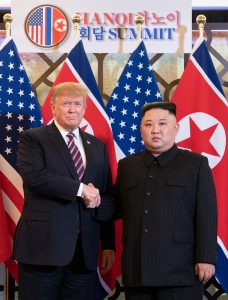4.4: The President's Foreign Policy Powers
- Page ID
- 134548
“My fellow Americans: As President and Commander in Chief, it is my duty to the American people to report that renewed hostile actions against United States ships on the high seas in the Gulf of Tonkin have today required me to order the military forces of the United States to take action in reply.”
–President Lyndon Johnson, escalating U.S. involvement in Vietnam in 1964 (1)
Commander in Chief
The president is commander in chief of U.S. military forces. In other words, the president is a civilian in charge of the U.S. military. Generals and admirals must take orders from him. Indeed, recent presidents have become quite involved in managing the armed forces. Here are some examples:
- Without a congressional declaration of war, President Harry Truman ordered U.S. troops into battle to defend South Korea in 1950. When General Douglas MacArthur, commander of U.S. troops in Korea, made reckless statements about bombing China and spoke to congressmen about Truman’s poor strategy, he was relieved of his command. Most people recognized the president’s constitutional right to make the decision.
- With congressional authorization—although not a formal declaration of war—President George H. W. Bush launched an invasion of Iraq in response to Iraq invading Kuwait. Then, he unilaterally made the decision to halt the war’s ground phase before Iraqi President Saddam Hussein was ousted.
- Following the 9/11 attacks, President George W. Bush’s administration decided to invade Iraq even though that country had nothing to do with the attacks. The Bush administration had previously invaded Afghanistan, whose Taliban regime had sheltered Osama bin Laden and the al-Qaeda network.
- Without a declaration of war, although with congressional support, President George W. Bush initiated a pre-emptive war on Iraq in 2003 that removed Saddam Hussein from power.
Congress has tried unsuccessfully to restrain presidential commander-in-chief powers. For instance, Congress passed the War Powers Resolution in 1973 over President Nixon’s veto. The Resolution stipulates that
- presidents consult with Congress when possible before committing U.S. military forces to action
- forces are to be withdrawn after sixty days unless Congress either declares war or grants a use-of-force extension
- Congress can pass a concurrent resolution ending American use-of-force at any time.
Presidents of both parties have considered the resolution to be unconstitutional, but it has never come before the Supreme Court. By and large, Congress has not been able to muster the political will to challenge presidents on war issues. When it does, it runs into constitutional limitations. For example, in 2019 Congress passed a bipartisan resolution to end the U.S.’s support for Saudi Arabia’s war in Yemen. President Donald Trump vetoed the resolution, and America continued to assist Saudi Arabia. (3)
Diplomatic Powers

In foreign affairs, the president has treaty power, or the ability to negotiate and sign formal agreements with other countries. These treaties require ratification by a two-thirds Senate vote. Most treaties are ratified. However, there are notable exceptions. In 1919, the Treaty of Versailles was negotiated and signed by President Woodrow Wilson, officially ending World War I and creating the League of Nations. The Senate refused to ratify the treaty, and the United States never did join the League of Nations. In 1999, President Bill Clinton could not round up enough Senate votes to ratify the Comprehensive Test Ban Treaty, which would have banned all nuclear weapons testing.
Because the formal treaty process is so onerous, presidents have more frequently turned to creating executive agreements, which are agreements with at least one other country’s head of state. These documents have the same force as treaties. Since they do not require Senate approval, an incoming president can stop honoring or can renegotiate executive agreements entered into by previous presidents. For example, in 2019 President Donald Trump formally announced that the U.S. was withdrawing from the Paris Climate Agreement, whose goal was to limit global temperature increases to below 2 degrees Celsius from the preindustrial average.
The North American Free Trade Agreement between Canada, the United States, and Mexico is an economic example of an executive agreement. As commander in chief, the president often negotiates status of force agreements—a type of executive agreement—with other heads of state in countries where the U.S. has stationed military personnel.
According to the U.S. Constitution, a president can “receive ambassadors and other public ministers.” In other words, the president, acting without Congress’ approval, has diplomatic-recognition power. When two countries receive ambassadors from each other, a diplomatical-recognition has occurred. The United States diplomatically recognizes most countries of the world. However, the U.S. does not diplomatically recognize North Korea, although the two countries have been negotiating for years over Korean peninsula security matters or Bhutan, which has a long-running border dispute with the People’s Republic of China.
References
- Lyndon Johnson speechto the nation. August 4, 1965.
- Charlie Savage, “2 Top Lawyers Lost to Obama in Libya War Policy Debate,” New York Times. June 17, 2011.
- Ed Pilkington, “Dismay as Trump Vetoes Bill to End US Support for War in Yemen,” The Guardian. April 17, 2019.
- Glen S. Krutz and Jeffrey S. Peake, Treaty Politics and the Rise of Executive Agreements. International Commitments in a System of Shared Powers. The University of Michigan Press, 2009. Page 30.
Media Attributions
- Trump and Kim © Shealah Craighead is licensed under a Public Domain license

